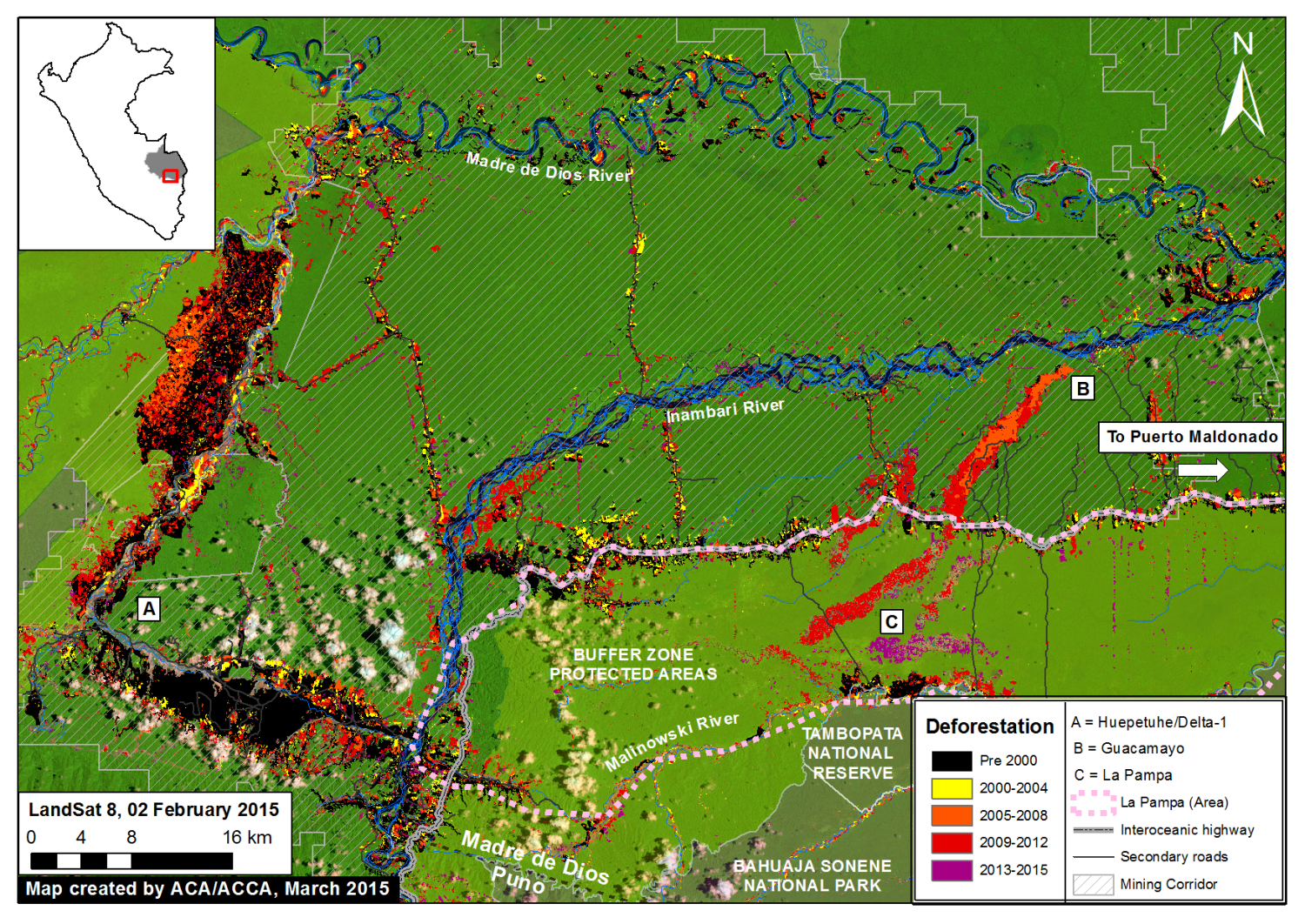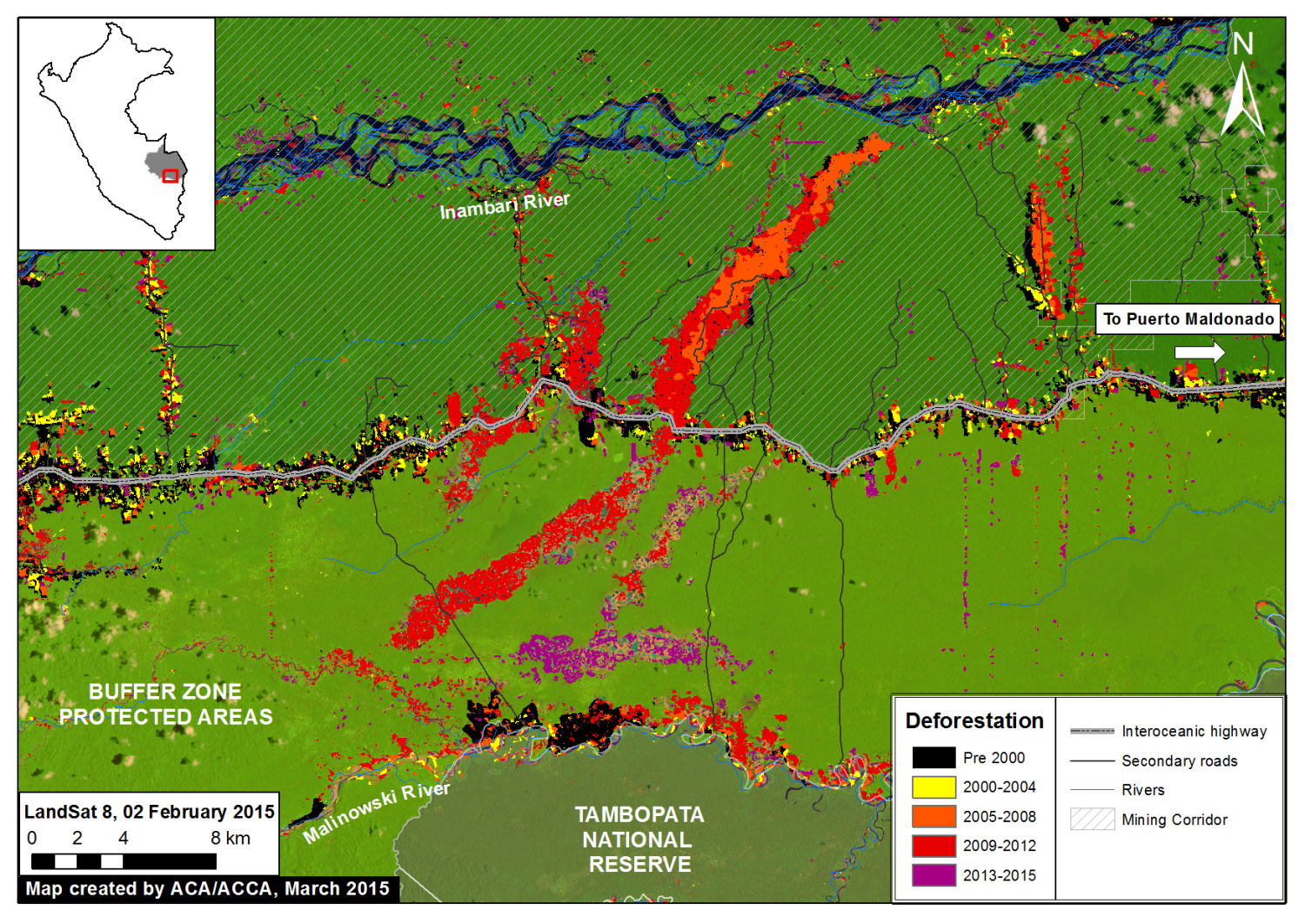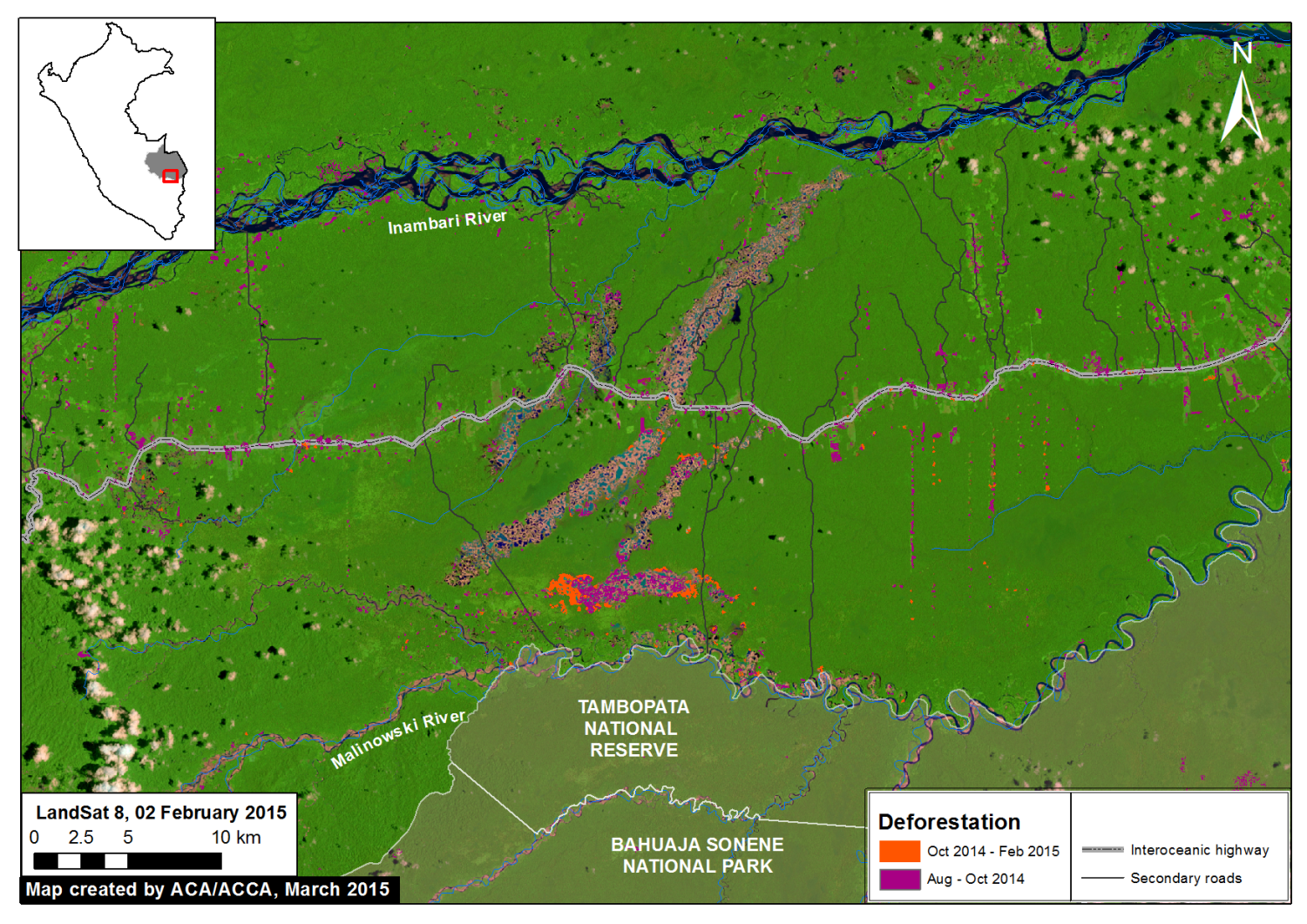Report #15 // January 28, 2015 – March 17, 2015
Top Stories
-
Antonio Fernández Jeri has been appointed as the new High Commissioner of Mining Formalization and the Interdiction of Illegal Mining.
-
The Amazon Conservation Association issued a new map showing that gold mining-driven deforestation grew by 226.5 hectares between October 2014 and February 2015 in the buffer zone of the Tambopata National Reserve.
-
A new report found that miners from Ecuador are using a series of underground tunnels to smuggle illegal gold from the Amazonas department of Peru.
Deforestation
-
A new analysis conducted by the Amazon Conservation Association (ACA) found that, despite government efforts to crack down on illegal gold mining, mining-driven deforestation in the buffer zone of the Tambopata National Reserve in Madre de Dios grew by 226.5 hectares between October 2014 and February 2015.[1] This deforestation is the equivalent of 310 soccer fields in just four months.
Formalization Process
-
The Presidency of the Council of Ministers (PCM) appointed Antonio Fernández Jeri as the new High Commissioner of Mining Formalization and the Interdiction of Illegal Mining. Fernández is the third person to hold this title, following Augusto Soto Castagnola and Daniel Urresti. He is now responsible for coordinating and overseeing the implementation of the national strategy to combat illegal mining.[2]
-
More than 2,000 informal miners met in Arequipa to demand a more efficient formalization strategy, under the leadership of economist Hernando de Soto of the Institute for Liberty and Democracy (ILD), a think-tank that focuses on helping developing countries modernize their economies. The new “true formalization” process will supposedly be more supportive of miners enrolled in the process and will include a plan to protect and remediate the environment. In contrast to the present formalization process, the plan will also contain different procedures for miners depending on region (coast, mountains, or rainforest). The proposal is set to be completed in 45 days and then sent to the Executive for approval.[3,4]
-
The regional president of Madre de Dios, Luis Otsuka, met with Peruvian President Ollanta Humala to address the issue of mining formalization. Prior to the meeting, the general manager of the regional government of Madre de Dios declared the process a “failure” in need of “integral revision.”[5] Otsuka reported that the first meeting with Humala yielded positive results in that the two leaders definitively agreed that the formalization process must be amended in order for “real” formalization to occur.[6] More concrete changes will likely develop out of further meetings, during which Otsuka hinted that the two will discuss amending Supreme Decree 016-2014, a controversial law regulating fuel supply, which Otsuka says negatively affects the region’s economy.[7]
-
To date, only eight mining companies have successfully completed the formalization process in Peru, all in the department of Puno. Around 70,000 miners initially registered for formalization.[8] Still, no informal miners have been formalized in Madre de Dios.
-
The Public Defender (Defensoría del Pueblo) analyzed the efficacy of the government’s strategies to eliminate illegal mining, including formalization and remediation of the environment. It found that the most significant difficulties were minimal budget dedicated to formalization, lack of qualified leaders and personnel, inadequate planning, and insufficient supervision.[9]
Illegal Gold Smuggling
-
A report aired on Peruvian news program Panorama showing that illegal miners from Ecuador are extracting gold from Peruvian territory in the Amazonas department through a series of 150 underground tunnels which are up to two kilometers long. The tunnels are used both to extract gold and to transport it illegally, and are used by both Peruvian and Ecuadorian miners.[10] The government plans to intervene in the area through raids on illegal mining operations and inspections of key checkpoints in the area.[11,12]
-
The President of the Central Reserve Bank of Peru denounced Bolivia for exporting US$1 billion more in gold in 2014 than the country has the capacity to produce. Analysts suspect that the gold was sourced illegally from Peru and then smuggled over the border due to inadequate customs control.[13]
Mercury Regulation
-
A new peer-reviewed study by the Royal Society of Chemistry found that mercury pollution from illegal mining sites moves rapidly downstream and can impact communities as least 560 kilometers (350 miles) away. According to the study, communities along the Madre de Dios River and its tributaries are at risk and should avoid regular consumption of carnivorous fish.[14,15]
-
The Alliance for Responsible Mining (ARM) has developed a new “fairmined” mining standard in an effort to promote sustainable mining. Currently, the AURELSA mine in Madre de Dios is one of the only companies in Peru to achieve the fairmined standard. To get the fairmined certification, a mining company must reduce their mercury emissions by 60 to 90 percent, ensure that chemical waste is disposed of safely, and guarantee worker’s rights. Buyers of fairmined gold pay a premium of ten percent which is then reinvested in the company and the interests of the local community.[16]
Other
-
Inspectors from the National Customs and Tax Administration (Sunat) seized 2,507 gallons of diesel fuel that was being transported along the Inambari River in Madre de Dios without the required documentation, destined for illegal mining operations.[17] A second seizure occurred a few weeks later, coordinated by the regional police and Sunat, during which 1,800 gallons of fuel were confiscated along the Madre de Dios River.[18] Sunat says it has increased its operational actions along the rivers and tributaries in the region.
-
The Magistrate Control Office (OCMA) found that the chief judge and president of the Court of Madre de Dios, John Russel Hurtado Centeno, was running an illegal mining camp called “Guadalupe” while simultaneously serving in the court system. He has been suspended indefinitely from his position while investigations continue.[19]
-
The Peruvian government found that gold production in the country fell by 6.7% in 2014 relative to 2013, yet Peru is still the sixth largest gold producer globally. The decrease is likely due to lower production in the largest mine in the country, Yanacocha.[20] Additionally, it is estimated that gold production in Madre de Dios will fall by 20% in 2015, largely due to the government’s offensive on illegal mining in the region.[21]
Notes: The ACA Mining News Watch focuses mostly on issues pertaining to the Peruvian Amazon and may not cover issues related to non-Amazonian parts of the country. We would like to credit ProNaturaleza’s “Observatorio Amazonia” as our primary resource for articles related to illegal mining in Peru.
Featured image credit: Gobierno Regional de Madre de Dios GOREMAD
Download the complete report in PDF
- Mining News Watch #14 (January 27, 2015) (pdf)
- Mining News Watch #13 (December 18, 2014) (pdf)
- Mining News Watch #12 (November 19, 2014) (pdf)
- Mining News Watch #11 (October 21, 2014) (pdf)
- Mining News Watch #10 (September 18, 2014) (pdf)
- Mining News Watch #9 (August 13, 2014) (pdf)
- Mining News Watch #8 (July 17, 2014) (pdf)
- Mining News Watch #7 (June 13, 2014) (pdf)
- Mining News Watch #6 (May 21, 2014) (pdf)
- Mining News Watch #5 (May 5, 2014) (pdf)
- Mining News Watch #4 (April 14, 2014) (pdf)
- Mining News Watch #3 (March 31, 2014) (pdf)
- Mining News Watch #2 (March 1, 2014) (pdf)
- Mining News Watch #1 (February 17, 2014) (pdf)























